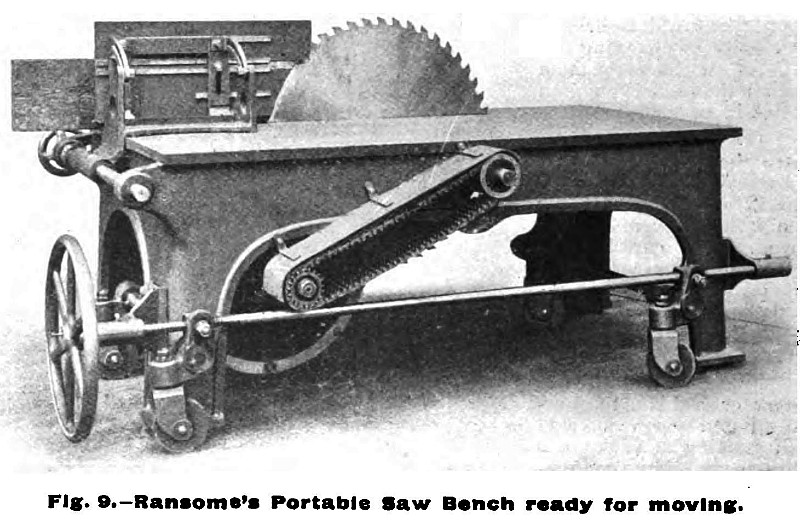|
Title: |
1905 Article-A. Ransome & Co., Portable Saw Bench |
|
Source: |
Timber & Woodworking Machinery, Special Issue, 15 Mar 1905 |
|
Insert Date: |
12/17/2016 8:34:39 PM |
Fig. 7 represents an electrically driven horizontal log band-saw by with the axis. The bearings are of the automatic ring oiling type. It is A. Ransome & Co., Ltd., Newark-on-Trent.
In this machine, the saw pulley axle is connected direct with the motor by means of a Renold’s silent driving chain, 8-in. wide by 1¾-in. pitch. The motor is carried on a platform supported on a strong steel screw provided with a gun-metal nut, which is fitted with a worm-wheel. This worm-wheel is actuated by a worm fitted to a horizontal shaft and driven by the same gearing operating the shaft carrying the worms, which actuate the two screws on the machine itself for raising the saw-carriage to suit different thicknesses of cut and by this means the motor and saw-carriage are maintained in their relative positions. The raising gear rests on a strong ball-thrust collar, by means of which the friction is reduced to a minimum. The feed and saw-raising gear is driven by a separate motor coupled direct to the driving shaft. The total width of the floor space occupied by this machine when driven as above described is only 18-ft. 6-in., and when, in addition to this, it is remembered that neither countershaft nor belting are required under the new conditions, the advantages to be derived from the Direct Electric Drive will be immediately patent to all who have a practical knowledge of machinery. The motors usually employed for driving are of the four-pole protected type. The frame and magnet cores are made of cast-steel of high permeability, and the latter are circular in cross section. The magnet coils are of best high conductivity copper, and are wound on separate formers which are easily replaced. The armature is of the slotted drum type, built up of special armature iron about No. 24 S.W.G. in thickness. The armature winding consists of coils formed and thoroughly insulated before they are laid in the slots. The commutator is mounted on a separate sleeve, having air passages parallel with the axis. The bearing are of the automatic ring oiling type. It is claimed that these motors will carry an overload of 25 per cent. for at least In this machine the saw pulley axle is connected direct with the one hour without injurious heating or sparking.
It not infrequently happens in timber and shipbuilding yards that, from various causes, it is more convenient to take a saw bench to the material to be sawn than to bring the wood to the machine, and, in bringing out a handy an practical bench to meet the former case, A. Ransome and Co., Ltd., of Newark-on-Trent, have supplied a long-felt need.
The bench, which is of the firm’s standard type, will take saws up to 36 in. in diameter, and is entirely self-contained, being driven by a 13 b.h.p. electric motor of Laurence and Scott's make, and of the four-pole totally-enclosed type.
The motor is bolted in an inverted position to the underside of the table, and is connected to the saw cast-iron canting fence, which is so adapted as to be quickly turned over the end of the bench when used for the last-named purpose.
The portability of the bench is obtained by means of four roller castors fitted with ball bearings, and arranged so that, when the large hand-wheel shown at the front of the bench is revolved, the rollers are lowered on to the ground, while at the same time the bench is raised clear of it, thus enabling the bench to be wheeled about in any desired direction.
Fig. 8 represents the machine in working order, with the legs of the standard on the ground, while in Fig. 9 it is shown resting on the roller castors, and ready to be removed.
Although this bench is of solid construction, the arrangement of the rollers and bearings is such that it can be easily transported from place to place by one man, and the motor, being fixed under the top of the machine, is efficiently protected from the weather when it is found necessary to work the machine out of doors. |
|
 1905 A. Ransome & Co., Portable Saw Bench
1905 A. Ransome & Co., Portable Saw Bench
|
|